Search the Special Collections and Archives Portal
Search Results

Warren A. Bechtel Album of Hoover Dam: photographic print
Date
Description
Evelyn Stuckey Papers
Identifier
Abstract
The Evelyn Stuckey Papers date from 1940 to 1972 and document Stuckey's experience as a physical education teacher at Las Vegas High School (LVHS) in Las Vegas, Nevada and founder of the LVHS Rhythmettes dance group. The collection contains personal and educational materials from Stuckey’s college years, personal correspondence, and photographs. It also contains materials documenting the Rhythmettes' activities including travel plans, posters and fliers, news clippings, and group rosters.
Archival Collection
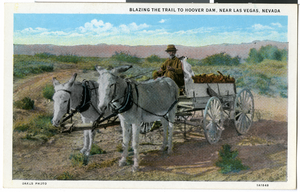
Postcard of a man with two burros, Hoover Dam, circa 1930s
Date
Archival Collection
Description
Image
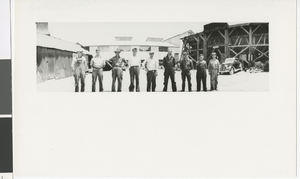
Photograph of mill workers, Pioche (Nev.), 1920s-1930s
Date
Archival Collection
Description
Image
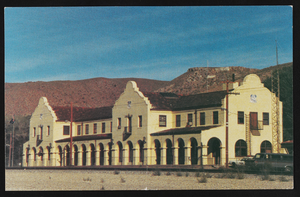
Railroad depot in Caliente, Nevada: postcard
Date
Archival Collection
Description
Image
Dr. Deborah Kuhls oral history interview
Identifier
Abstract
Oral history interview with Dr. Deborah Kuhls conducted by Barbara Tabach on December 29, 2017 for the Remembering 1 October Oral History Project. In this interview, doctor Deborah A. Kuhls describes the preparation and procedures implemented at the University Medical Center of Southern Nevada (UMC) during the night of the October 1, 2017 mass shooting in Las Vegas, Nevada. She describes her experiences from that night and into the next morning, starting from when the trauma center first learned about the shooting to when patients began arriving. She goes into detail on the hospital's Military-Civilian Trauma System Partnership, which allowed for the installation of a second trauma area to treat the large volume of patients. In addition to the events at the hospital, Kuhls talks about the flurry of activities during the week of the shooting, including interviews with various media, the statewide meeting for surgeons, fellows, and residents where "stop the bleed" training was provided, and general meetings with various government officials, including Donald Trump. Deborah Kuhls also discusses the emotional impact of the shooting and its aftermath as well as her goals for the future of trauma in the medical field.
Archival Collection
C. D. Williams oral history interview
Identifier
Abstract
Oral history interview with C. D. Williams conducted by Edwin R. Smith on July 07, 1975 for the Ralph Roske Oral History Project on Early Las Vegas. In this interview, Williams discusses his career as a firefighter in Las Vegas, Nevada and the history of the Las Vegas Fire & Rescue Department. He describes his early history, moving to Las Vegas in 1942, and how he obtained his position in the Las Vegas Fire & Rescue Department. Williams also describes his training, the equipment they utilized, and how that equipment, as well as the fire department itself, has changed over time. He tells anecdotes of calls and his experiences in the department. Williams explains how the construction of the Basic Magnesium Plant and Nellis Air Force Base affected the fire department. He talks about how and why the Clark County Fire Department and North Las Vegas Fire Department were established, and how Las Vegas casinos paid the city for fire protection. Lastly, Williams discusses being drafted during World War II and his service as a military fire fighter.
Archival Collection
Garvin, Laura
Laura Garvin was born California. She graduated high school in Goldfield, Nevada, went to Los Angeles, California, and entered nurse’s training. After that, she returned to Nevada and worked until World War II started when her family lived in California again. Garvin returned to Nevada in 1946 and worked as a nurse in the city since then.
Person
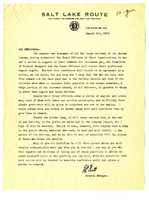
Letter from H. C. Nutt to San Pedro, Los Angeles, & Salt Lake Railroad employees, August 4, 1916
Date
Archival Collection
Description
Text
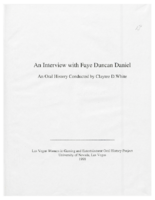
Transcript of interview with Faye Duncan Daniel by Claytee D. White, October 18, 1996
Date
Archival Collection
Description
Interview with Faye Duncan Daniel conducted by Claytee D. White on October 18, 1996. Beginning in clerical work at the Nevada Test Site, Daniel rose to become the Assistant Hotel Manager at Union Plaza Hotel and Casino. She established the Hotel Managers Association and the Professional Black Women's Alliance. After leaving the gaming industry, Daniel returned to school to train for a career in education. She worked closely with the Displaced Homemaker Program at the Community College of Southern Nevada and later with Help Centers of Southern Nevada.
Text
